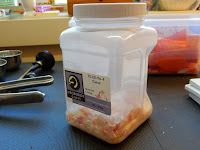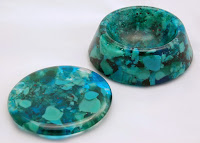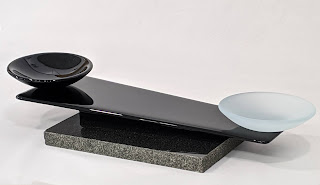Fused Glass Boxes Using Colour de Verre Casting Molds
 |
| Completed fused glass cast boxes |
A month or so ago, I purchased a second box mold. Don't ask me why... (maybe I should have worn out the first one before I bought another). I guess it's because every time one of the two cute little boxes I made in class catches my eye, I am intrigued to try again. So this weekend I decided to dust off the molds and give it another try. Following are a few notes on the process.
I have two boxes -- the 3.5" round box and the 6" elliptical box. Colour de Verre produces a tip sheet for its boxes and the tip sheet includes fill weight for the boxes and firing schedules. The instructions call for using frit, and I decided to make my own using the Aanraku frit crusher.
 |
| Weigh the glass before crushing frit |
I started by weighing out odds and ends of sheet glass on a standard kitchen scale set to weigh in grams. The round box mold called for 115 grams for the lid and 295 grams for the box, for a total of 410 grams (I weighed out a little extra). I washed the glass by putting it in a plastic pan, filling it with warm soapy water, and swirling the glass around with a paint brush that I use for this purpose (much safer than putting your hands in that pan!). I rinsed the glass well, and then dried it with a microfiber cloth.
 |
| Tools for crushing the frit |
Next, I used my mosaic nippers to "chunk up" (that's a technical term) the glass for the frit crusher. For whatever reason, the glass seemed to crush better when I did each color one at a time, rather than mixing the different glasses.
Keep in mind that you should wear safety glasses and a respirator when crushing frit. I also worked outside to minimize the dust in my studio.
 |
| Frit mixture, ready to fill boxes |
Once the glass was crushed, I combined it in an empty 4 pound frit jar and mixed it up. After mixing, I put a strong magnet in a baggie and put the baggie in the frit, and then gave the container several turns so the magnet could remove any metal in the frit from the frit crusher.
The molds were prepared using MR-97 mold release (Colour de Verre also has a tip sheet on using MR-97.) To fill the box pieces, I placed each piece on the scale, zeroed out the scale, and then poured in the appropriate amount of frit. I used a small stainless cup to scoop out the frit so that I got a good mixture of the different frit sizes.
I fired the boxes and lids according to the schedule given in the Colour de Verre tip sheet. The tip sheet suggested 30 to 60 minutes for the hold at the top temperature -- I watched the progress and skipped to the annealing segment after 40 minutes.
 |
| Boxes in the kiln |
Seg
|
Rate
|
Target
|
Soak
|
|
1
|
300
|
1250
|
30
|
|
2
|
300
|
1430
|
40
|
|
3
|
1500
|
950
|
90
|
|
4
|
50
|
800
|
01
|
|
5
|
100
|
600
|
00
|
 |
| More boxes in the kiln! |
The total firing schedule took about 13.5 hours, plus several more hours of cool-down time.
Tips:
I suggest using at least one third clear glass. Just like when doing pot melts or combings, dark and opaque glasses can overwhelm a piece.
The frit crusher makes all grains of glass, from powder to mosaic. I did not sift the glass, I used all the different grain sizes.
Make sure the boxes are completely cool before removing them from the kiln and washing them. Thicker pieces hold internal heat, and if the boxes are not completely cool they will crack!
I like the look of larger pieces of frit. Notice the base of the elliptical box -- I was short some frit when I filled the base, and used some medium opal "cotton candy" frit from a jar. I much prefer the pattern on the lid to that on the base.
Colour de Verre's tip sheet has information on fire-polishing the bases of the box if you wish, along with some ideas for enhancing the lids with dichroic glass, sheet glass, or tack-fused elements.


I hope this post has been informative and will inspire you to dust off that mold and give it a try!
Dana
Resources:
Color de Verre Project sheet library: http://www.colourdeverre.com/learn.php?c=8
Aanraku Frit Maker: http://www.aanraku.com/aanraku-frit-piston.html
Learn more about fusing! Bullseye offers educational videos for a small annual fee:


